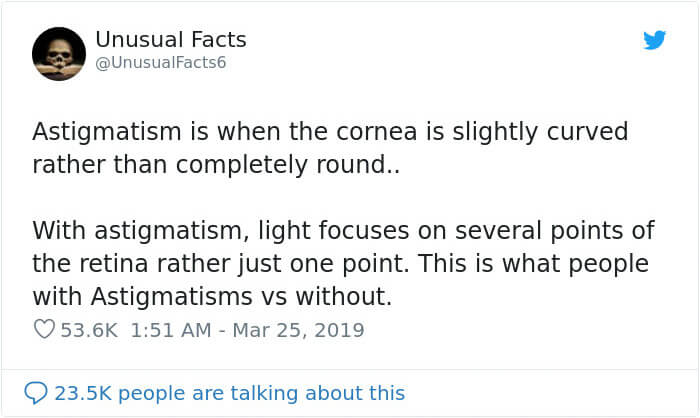
Just when you think you have seen it all, the internet provides unique and exciting facts that you never knew. How much do you know about the human eye? We know people who have perfect vision, while others are blind as a bat, but what about all those eye conditions that come between. A picture from the Twitter account @UnusualFacts6 – ‘which deals with the ‘most weird and horrific facts on the internet’ – has just gone viral for demonstrating the difference between what people with astigmatism see and what those without it see. Astigmatism is when the cornea (the front surface of the eye) is slightly curved and to see the way people with the condition experience lights is nothing short of illuminating.
Astigmatism is a refractive condition which occurs when the cornea or the lens inside the eye has mismatched curves. While a typical eye has both the cornea and lens curved in a rounded shape, people with astigmatism have one of those elements in an egg shape. In a perfect eye, the rounded shape of the cornea and lens refract any incoming light to produce a sharply focused picture on the retina.
In an eye with a refractive error, the mismatched curves in the eye block the light rays from bending properly. The result is a blurry picture. There are two different types of astigmatism: corneal astigmatism, when the inconsistent curves occur in the cornea, and lenticular astigmatism when the curves in the lens are mismatched. Both cause blurry vision yet can occur more horizontally, vertically or diagonally. The condition is usually present combined with another refractive error like nearsightedness (myopia) or farsightedness (hyperopia).
Blurry vision isn't the only symptom of astigmatism, people with this condition can also experience eyestrain or headaches, discomfort, difficulty seeing at night. Some people are born with astigmatism and might not know they have it until they're screened for it during an eye test. People who find out they have astigmatism can still live relatively hassle-free lives. The most common way to treat the symptoms for astigmatism are glasses, contact lenses, and refractive surgery.
Refractive errors are the most common of the ocular problems amongst all age groups. According to World Health Organization's studies and reports, they're also the first cause of visual impairments and the second cause of visual loss worldwide, as 43 percent of global visual impairments are due to refractive errors. Uncorrected refractive errors were the cause of blindness in 6.8 million people around the world in 2010. In the US astigmatism occurs in 1 out of 3 people.





People with astigmatism were surprised by the contrast:











While having an eye condition may seem like a great impairment it didn’t stand in the way for many great artists.

Painter, architect, and sculptor El Greco of the Spanish Renaissance (1541-1614) is believed to have had astigmatism. According to Bored Panda, the artist was known for drawing elongated figures in his paintings which ophthalmologist Germán Beritens argued in 1913 was due to his refractive condition. A more substantial example is that of Claude Monet who was diagnosed with cataracts, a condition that clouds the eyes and vision, impairs color discrimination, and impairs detail – all of which were evident in his work.















Not sure I understand - which photo is with and which without astigmatism? Or... are they both with astigmatism?
ReplyDelete